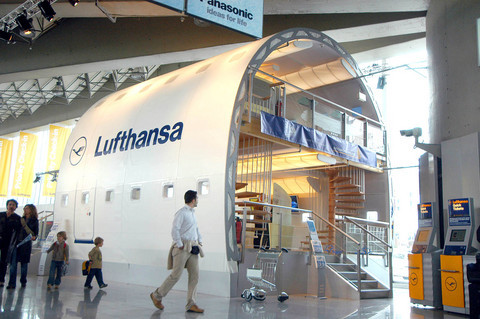Now that the Airbus A380 has taken to the skies on its first test flight, this giant bird needs someplace to land. For Airbus, selling its new superjumbo jet to the world's airports has been only slightly less strenuous than selling it to airlines.
Representatives of airports in Europe, Asia, and the US gathered here on Thursday, energized after Wednesday's smooth flight, to discuss how they are getting ready for the A380, which is scheduled to go into service in the middle of next year with Singapore Airlines.
But as the talk at the conference drifted to the costly, unglamorous business of reinforcing taxiways and retrofitting gates, some of the excitement faded. The A380, people here acknowledge, is going to be more of a burden, and a risk, for airports than Airbus likes to suggest.

PHOTO: NY TIMES
"What's going to happen when two of these planes arrive at the same time and dump 1,000 people into immigration and baggage claim?" said John Kasarda, an expert on airports and professor of business administration at the University of North Carolina.
Preparing for all these people, and buttressing runways for a plane that can weigh 544 tonnes on takeoff, is not cheap. It will cost airports an average of US$100 million to upgrade their facilities, according to industry studies. Heathrow Airport near London is spending US$857 million.
For Heathrow, one of the world's most congested fields, that heavy investment may pay off. By 2016, analysts estimate, the A380 could account for one of every eight flights there. That would increase Heathrow's capacity by nearly 10 million people without adding a single new flight.
But for airports that will attract only a handful of A380s, the arithmetic is more troubling. Among the busiest airports, Hartsfield-Jackson in Atlanta has said it plans no upgrades for the A380; O'Hare in Chicago has not yet decided. Only Kennedy, Los Angeles International, San Francisco International and Miami International among US airports are committed to the plane.
"What happens if you spend US$100 million, and your only airline with an A380 flight cancels it?" said Kasarda, who was chairman of the conference here. "This industry is turbulent and unforgiving."
Airbus, which is based in Toulouse, France, brushed aside such worries.
"Why would airports not want to adapt? They'll have to adapt," said Richard Carcaillet, the head of product marketing for the A380.
Carcaillet's confidence stems from what he describes as the A380s remarkably strong order book. Airbus has firm orders and commitments for 154 planes from 15 customers -- distributed among Europe, the Middle East, and Asia. But among American carriers, only FedEx and United Parcel Service have ordered A380s -- 10 freighters each.
Few people predict that major airports will not be ready for the A380. But there may be some close calls. Los Angeles International wants to move one of its four runways several feet to the south to create a center taxiway wide enough to be used by A380s after they land.
But the plans have been bogged down in litigation, and Los Angeles World Airports, the authority that runs the airport, is not sure it will finish construction before the first flight is expected there, in November next year. It says it has a backup plan: obtaining Federal Aviation Administration approval for the plane to land on one of the other runways.
The airport has had to compromise in other ways. Because space is at such a premium, it is converting only two gates at the Tom Bradley International Terminal to serve A380s. To compensate, it is setting up two other gates on the airfield away from the terminal.
"The airlines would prefer not to use these, but it gives us overflow capacity," Mark Massman, deputy executive director of Los Angeles World Airports, said in a telephone interview.
Virgin Atlantic Airways, one of the first buyers of the A380, has cited the restrictions in Los Angeles as one of the reasons it pushed back delivery of its six planes until early 2008.
Massman predicted that Los Angeles would nonetheless be a hub airport for the A380, because it is a gateway for travelers from Asia. But as to the A380s potential for easing congestion, one of the advantages cited by Airbus, he said it would be only a "minor improvement."
It may be little surprise that most American airports seem less enthusiastic about the A380 than their European counterparts. Airbus, after all, is a European pet project -- owned by its military contractors and backed by the leaders of France, the UK, Germany, and Spain.
US airports are limited by tight budgets and aging facilities. At Kennedy, for example, the Port Authority of New York and New Jersey is spending US$130 million on two mundane projects to accommodate the A380: reinforcing two bridges that carry planes over highways, and shifting a taxiway that rings the terminals. The authority estimates that the A380 will generate US$233 million a year in benefits for the region by 2016 in new jobs and other revenue.
Fraport, the company that owns Frankfurt airport, did not even mention costs in outlining its plan to build 12 A380 gates in two terminals. It also plans a cavernous maintenance building for Lufthansa's 15 super-jumbos. And Charles de Gaulle Airport north of Paris is building a satellite terminal with six A380 gates.
But the Europeans have nothing on the Persian Gulf emirate of Dubai. Its airline, Emirates, ordered 43 A380s, the largest single order, and the home airport is thinking big. Coming in 2008: a US$4.1 billion terminal, with two concourses able to handle 23 A380s. Passengers will board on both the lower and upper decks.
Dubai is not stopping there. Betting that 100 million passengers a year will pass through by 2020, it is building a second airport nearby. "We're building a special airport for the A380," said Rimzie Ismail, the marketing manager for Dubai's civil aviation department.

SECURITY: As China is ‘reshaping’ Hong Kong’s population, Taiwan must raise the eligibility threshold for applications from Hong Kongers, Chiu Chui-cheng said When Hong Kong and Macau citizens apply for residency in Taiwan, it would be under a new category that includes a “national security observation period,” Mainland Affairs Council (MAC) Minister Chiu Chui-cheng (邱垂正) said yesterday. President William Lai (賴清德) on March 13 announced 17 strategies to counter China’s aggression toward Taiwan, including incorporating national security considerations into the review process for residency applications from Hong Kong and Macau citizens. The situation in Hong Kong is constantly changing, Chiu said to media yesterday on the sidelines of the Taipei Technology Run hosted by the Taipei Neihu Technology Park Development Association. With

CARROT AND STICK: While unrelenting in its military threats, China attracted nearly 40,000 Taiwanese to over 400 business events last year Nearly 40,000 Taiwanese last year joined industry events in China, such as conferences and trade fairs, supported by the Chinese government, a study showed yesterday, as Beijing ramps up a charm offensive toward Taipei alongside military pressure. China has long taken a carrot-and-stick approach to Taiwan, threatening it with the prospect of military action while reaching out to those it believes are amenable to Beijing’s point of view. Taiwanese security officials are wary of what they see as Beijing’s influence campaigns to sway public opinion after Taipei and Beijing gradually resumed travel links halted by the COVID-19 pandemic, but the scale of

A US Marine Corps regiment equipped with Naval Strike Missiles (NSM) is set to participate in the upcoming Balikatan 25 exercise in the Luzon Strait, marking the system’s first-ever deployment in the Philippines. US and Philippine officials have separately confirmed that the Navy Marine Expeditionary Ship Interdiction System (NMESIS) — the mobile launch platform for the Naval Strike Missile — would take part in the joint exercise. The missiles are being deployed to “a strategic first island chain chokepoint” in the waters between Taiwan proper and the Philippines, US-based Naval News reported. “The Luzon Strait and Bashi Channel represent a critical access

Pope Francis is be laid to rest on Saturday after lying in state for three days in St Peter’s Basilica, where the faithful are expected to flock to pay their respects to history’s first Latin American pontiff. The cardinals met yesterday in the Vatican’s synod hall to chart the next steps before a conclave begins to choose Francis’ successor, as condolences poured in from around the world. According to current norms, the conclave must begin between May 5 and 10. The cardinals set the funeral for Saturday at 10am in St Peter’s Square, to be celebrated by the dean of the College